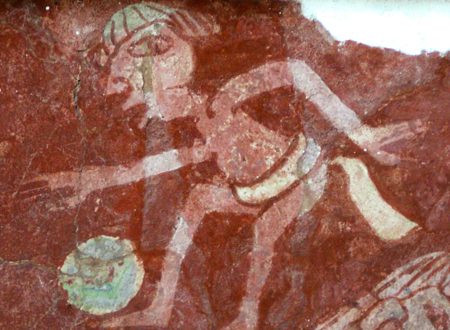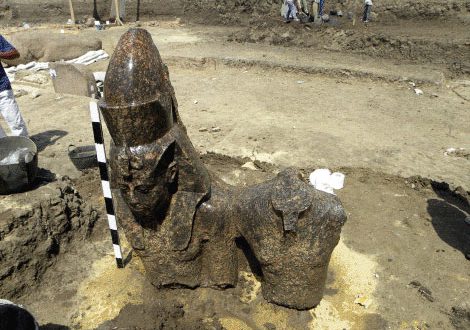 A water feature excavated in the Maya city of Palenque, in Chiapas, southern Mexico, is the earliest known example of engineered water pressure in the New World, according to a collaboration between an archaeologist and a hydrologist from Penn State University. The spring-fed conduit has a restricted opening that would cause the water to exit forcefully, under pressure, to a height of 6 metres. How the Maya used the pressurized water is, however, still unknown. Such water pressure systems were previously thought to have entered Mexico with the arrival of the Spanish in the 16th century.
A water feature excavated in the Maya city of Palenque, in Chiapas, southern Mexico, is the earliest known example of engineered water pressure in the New World, according to a collaboration between an archaeologist and a hydrologist from Penn State University. The spring-fed conduit has a restricted opening that would cause the water to exit forcefully, under pressure, to a height of 6 metres. How the Maya used the pressurized water is, however, still unknown. Such water pressure systems were previously thought to have entered Mexico with the arrival of the Spanish in the 16th century.
“Water pressure systems were previously thought to have entered the New World with the arrival of the Spanish,” the researchers said in a recent issue of the Journal of Archaeological Science. “Yet, archaeological data, seasonal climate conditions, geomorphic setting and simple hydraulic theory clearly show that the Maya of Palenque in Chiapas, Mexico, had empirical knowledge of closed channel water pressure predating the arrival of Europeans.”
The area of Palenque was first occupied about the year 100 but grew to its largest during the Classic Maya period 250 to 600. The city was abandoned around 800. More than 50 springs have been recorded at the Palenque site, and aside from these springs, the site can expect more than 2000mm of rainfall annually. For comparison, on average, London receives just below 650 millimetres per annum. No wonder the Maya citys central district was named Lakam Ha, meaning Big Water.
 The feature PB-A1, first identified in 1999 during a mapping survey of the area, while similar to the aqueducts that flow beneath the plazas of the city, was also unlike them. In 2006, Kirk French, lecturer in anthropology, returned to Palenque with Christopher Duffy, professor of civil and environmental engineering, to examine the unusual water feature.
The feature PB-A1, first identified in 1999 during a mapping survey of the area, while similar to the aqueducts that flow beneath the plazas of the city, was also unlike them. In 2006, Kirk French, lecturer in anthropology, returned to Palenque with Christopher Duffy, professor of civil and environmental engineering, to examine the unusual water feature.
It is a spring-fed passage located on steep terrain, dropping about 6 metres from the entrance of the tunnel to the outlet about 60 metres downhill. The cross section of the feature decreases from about 3 square metres near the spring to about 0.15 square metres where water emerges form a small opening. The combination of gravity on water flowing through the Piedras Bolas Aqueduct and the sudden restriction of the conduit causes the water to flow out of the opening forcefully, under pressure. At the outlet, the pressure exerted could have moved the water upwards of 6 metres.
The Piedras Bolas Aqueduct is partially collapsed so very little water currently flows from the outlet. French and Duffy used simple hydraulic models to determine the potential water pressure achievable from the Aqueduct. They also found that the aqueduct would hold about 65,000 litres of water if the outlet were controlled to store the water.
“Under natural conditions it would have been difficult for the Maya to see examples of water pressure in their world,” said Christopher Duffy. “They were apparently using engineering without knowing the tools around it. This does look like a feature that controls nature.”
Underground water features such as aqueducts are not unusual at Palenque. Build on a narrow escarpment, surrounded by steep hills, inhabitants were unable to spread out. In order to increase the areas of liveable terrain, the Palenquenes constructed a large number of subterranean aqueducts, routing the pre-existing streams beneath plazas as well as bridges, damns, drains and pools. These spring-fed streams combined with the downpours during the six-month rainy season also presented a flooding hazard that the aqueducts would have at least partially controlled.
 “They were creating urban space,” said Kirk French. “There are streams in the area every 300 feet or so across the whole escarpment. There is very little land to build on. The experience the Maya at Palenque had in constructing aqueducts for diversion of water and preservation of urban space may have led to the creation of useful water pressure.”
“They were creating urban space,” said Kirk French. “There are streams in the area every 300 feet or so across the whole escarpment. There is very little land to build on. The experience the Maya at Palenque had in constructing aqueducts for diversion of water and preservation of urban space may have led to the creation of useful water pressure.”
One potential use for the artificially engineered water pressure would have been a fountain. The researchers modelled the aqueduct with a fountain as the outlet and found that even during flood conditions, water would flow in the aqueduct, supplying the fountain, and above ground in the channel running off the slope.
Another possibility could be to use the pressure to lift water onto the adjacent residential area for use as wastewater disposal.





